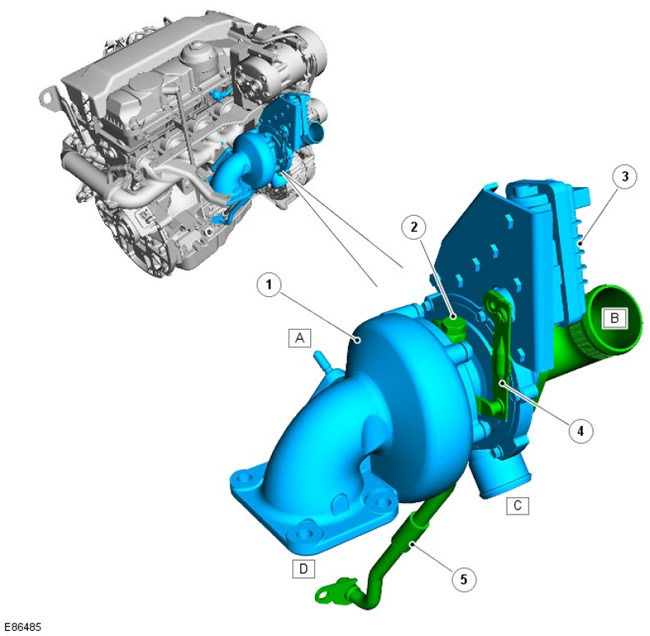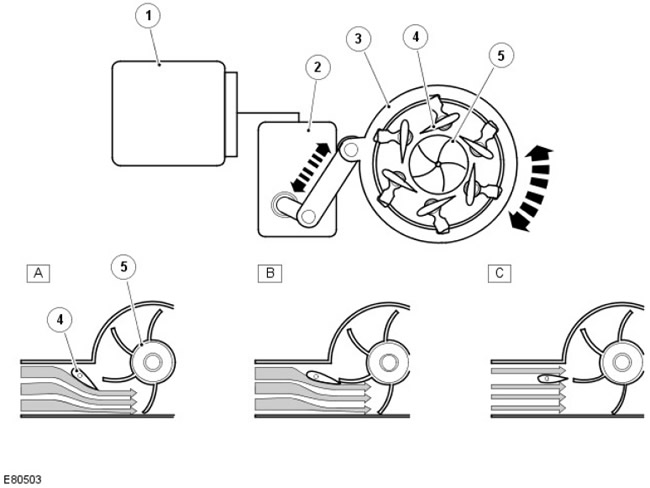Location of elements

| Pos. | spare no | Name |
| d | parts | Exhaust manifold connection |
| B | - | Air intake connection |
| C | - | Intercooler connection (charge air intercooler) |
| D | - | Exhaust pipe connection |
| 1 | - | turbocharger housing |
| 2 | - | Oil supply |
| 3 | - | Drive motor |
| 4 | - | drive lever |
| 5 | - | Return oil line |
A variable nozzle turbocharger mounted on the exhaust manifold makes it possible to vary the flow of exhaust gases from the turbine depending on the operating mode of the engine. This leads to an increase in the power available to the turbine, especially in the region of low crankshaft speeds, and to an increase in boost pressure. With an increase in engine speed, the blades of the apparatus gradually move to the open position, maintaining the balance of power realized on the wheel in accordance with the requirements of speed and load modes. Compared to traditional HR, where bypass valves are used, HR with an adjustable nozzle apparatus has a higher efficiency.
Advantages:
- High engine torque at high and low rpm
- Continuous and smooth control at all speeds of the engine
- No boost pressure regulator required, better use of exhaust gas energy, less back pressure for the same compressor operation
- Low thermal and mechanical load increases the energy performance of the engine
- Lower toxicity of exhaust gases
- Optimization of specific fuel consumption in the entire speed range of the engine
The drive shaft is driven by a rotary drive DC motor. The drive shaft is connected to the blades by a drive lever. Moving the lever causes the blades of the apparatus to move. The rotation of the drive shaft generates a feedback signal that carries information about the angular position of the blades. This information is transmitted to the engine control unit (ECM).
The turbocharger provides fail-safe operation. In the event of a control failure, the machine's blades default to the fully open position to reduce the boost to a minimum. The engine control unit monitors the faults of the stepper motor and generates fault codes.
Work principles

| Pos. | spare no | Name |
| A | parts | Low engine crankshaft speed |
| B | - | Average engine speed |
| C | - | Maximum engine crankshaft speed |
| 1 | - | ECM |
| 2 | - | Drive motor |
| 3 | - | adjusting ring |
| 4 | - | Apparatus blades |
| 5 | - | turbine wheel |
A - Low engine speed
At low engine speeds, the exhaust gas volume is negligible, so the blades move towards the closed position to reduce the turbine intake cross-sectional area. This decrease causes an increase in the gas flow rate to the impeller, thereby increasing the impeller speed and boost pressure.
B - Average crankshaft speed
As the engine speed increases, the exhaust gas volume also increases. The blades move towards the open position to increase the turbine inlet area and maintain the gas velocity.
C - Maximum crankshaft speed
At maximum engine speed, the blades are almost fully open, maintaining the speed of the gas entering the turbine wheel.
Barometric pressure sensor
When the vehicle is operated at high altitudes, ambient pressure is reduced, causing the compressor wheel to do less work to generate the same boost pressure. To prevent overspeeding of the turbine under these conditions, a barometric pressure sensor located in the ECM protects the turbocharger by opening the vanes more to reduce impeller speed. This is called the high-altitude range of the turbocharger.
Turbocharger lubrication
When accelerating or decelerating hard, a uniform flow of clean oil is very important for a turbocharger. The oil supplied by the engine lubrication system lubricates the turbocharger shaft and bearings and acts as a coolant for the turbocharger center housing.
To maintain the expected life of the turbocharger, it is important that the oil can flow freely through the turbocharger and return to the crankcase without obstruction. Therefore, be sure to add the recommended amount of engine oil of the recommended quality at regular service intervals.
Charge air cooler
The charge air cooler is used to increase the density of the air supplied from the turbocharger to the intake manifold.
When the charge air is compressed in the turbocharger, the air temperature rises. This heat release reduces the density of the air, resulting in less oxygen entering the cylinders, which reduces engine power. To compensate for this disadvantage, the air passes through the charge air cooler before entering the engine. The temperature is reduced due to the release of heat into the atmosphere.
Cooling the intake air also helps to reduce exhaust emissions by limiting the production of nitrogen oxides (NOx).
Comments on this article